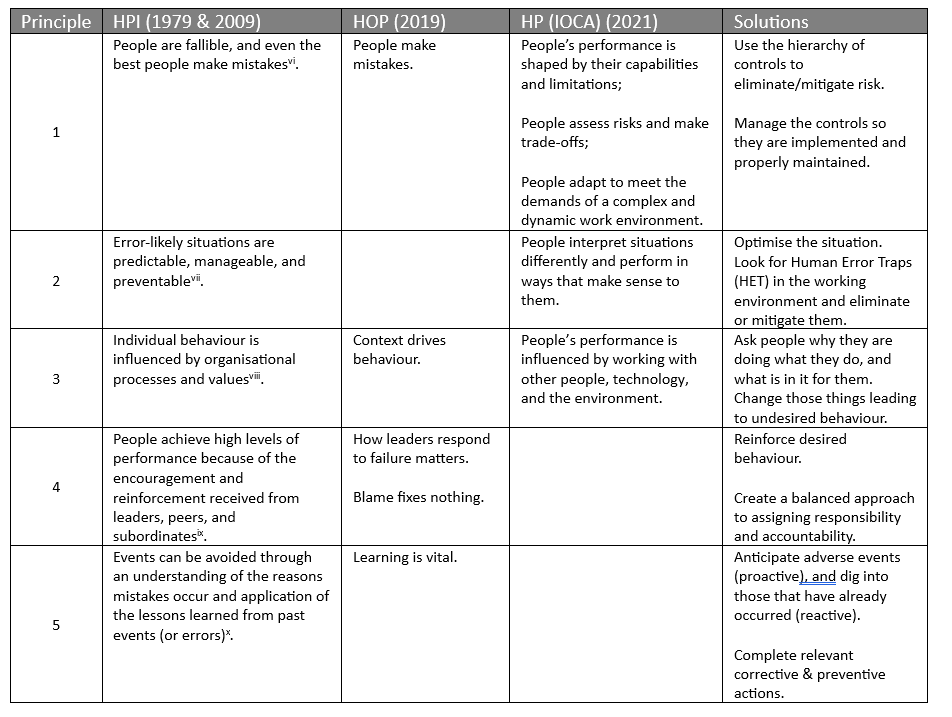Dom Cooper PhD takes a look at human performance concepts including influencing behaviour and making mistakes – is it really just human error or could it be avoided? And how should leaders respond to this?

Credit: Alamy Stock
In the spirit of learning, I recently asked people in the ‘new-view’ Human & Organisational Performance (HOP) [i] world how they translate high-level Human Performance (HP) principles into actions to improve safety.
HP might be better known as Human Factors, Human Error, or Ergonomics. It encompasses all those things, and views the human as an integral feature of any work system, adopting Rasmussen’s internal ‘inside-out’ approach to problem-solving, as opposed to an ‘outside-in’ view[ii].
Three known HP perspectives contain a set of five principles each (see Table 1). The foundational principles are contained in the US Department of Energy (DOE), 1979 & 2009 Human Performance Improvement (HPI) Handbooks[iii], [iv]. Predicated on these, HOP espouses five somewhat different principles. The International Organisation for Civil Aviation (IOCA) recently released another set[v].
Importantly, each principle set focuses on understanding the individual’s behaviour, with a view to changing the immediate environment so as to change that behaviour. With DOE HPI foundational principles as the anchor, I have aligned the principle sets with each other, as they make sense to me (some may disagree), and summarised solutions from the associated HPI/IOCA documentation:
 Where the rubber hits the road
Where the rubber hits the road
HPI and IOCA provide a package of implementation tools, processes, and/or mitigation suggestions. HOP doesn’t, which explains why so many adherents are reinventing the wheel. The following presents the five HOP principles in terms of lessons learned.
- The principle ‘Blame fixes nothing’ attracted many responses. It was noted that blame was treated differently in different cultures, but adopting the principle has led to trust where it was missing previously; keeping HR out of it was a common plea, as was creating a learning environment where people can openly discuss mistakes without fear of punishment.
Many pushed back, stating this HOP principle is a mantra divorced from context or an absolute phrase with no room for debate; evidence surfaced that blame facilitates learning[i], thus disproving the principle and destroying its rationale. In practice, the principle leads to incident investigations entirely ignoring the role of people in attempts to avoid apportioning blame, limiting the gathering of relevant information and diagnoses of root causes[ii]. UK Healthcare research[iii] argues a responsibility culture is preferable to a no-blame culture, while DOE’s HPI (Part 1) provides a culpability model to facilitate that.
- The ‘People make mistakes’ principle is a truism. Responses focused on persistent repeat errors as a main concern. Solutions focused on discussing errors and near-misses regularly; designing equipment features to support operator performance (e.g., colour-coding gauge backgrounds); introducing a “Don’t Know – Don’t Go” ethos, so workers who don’t know things will stop and seek aid; conducting safety critical task analysis to identify problem situations; defining critical controls that allow for safe failure; devising error tolerant systems, processes, and procedures; and adopting a learning approach from adverse events.
These responses speak to the workforce identifying and eliminating situational Human Error Traps (HET) within a structured process[iv].
- The ‘Learning is vital’ principle refers to an organisation’s ability to continually learn from itself. Responses highlighted how resistant organisations are to learning from incidents, even those adopting the principle as a mantra; a lack of resources seems common, accompanied by unenacted solutions.
Some promoted ‘learning from normal work’ by asking workers questions, while others warned of challenges faced with balancing learning with creating unnecessarily onerous processes; one described how a genuine safety partnership had been established by creating multiple feedback loops between employees and managers, in which everyone felt safe to learn.
The way forward is to use the organisation’s experience of adverse events and dig into them (reactive) to use that knowledge to anticipate them (proactive). Completing relevant corrective & preventive actions is considered a fundamental.
- The ‘Context drives behaviour’ principle is based on behaviourist principles that antecedents or precursors drive and shape behaviour, while consequences maintain them[v]. Similarly, Albert Bandura’s Social Learning Theory[vi] shows there is a tripartite reciprocal relationship between situation, behaviour and psychology. Responders talked about changing the system, not the people, to influence behaviour change.
This ignores the entirety of Bandura’s highly influential work and the lessons from Total Quality Management failures; initiatives should focus on all three! In practice, ask people why they are doing what they do, and what is in it for them. Change those things leading to or supporting undesired behaviour.
- The ‘How leaders respond to failure matters’ principle led to some valuable insights into how a caring response to a failure or violation can lead to winning over hearts and minds. The point was also made that leaders’ responses are often constrained by how workers respond (e.g., how do you respond if failure is frequently hidden?).
This further highlights the necessity of creating a genuine safety partnership between workers and their leaders[vii]. Such comments also reinforced the need for a balanced approach to culpability; the organisation needs to admit they (might have) created an imperfect situation while emphasising that workers also have a responsibility to work safely.
Summary
Human Performance concepts from the early 1970s were largely overlooked, even though the tools, methods, and practices were freely available. Currently, many think HP is something new, and are busy reinventing the wheel. My exploration has tried to sidestep that and focus on practical insights.
 Clearly, HP is all about behaviour: how to shape and influence it. Reducing unintended mistakes means identifying and eliminating Human Error Traps, and putting in and maintaining appropriate risk controls.
Clearly, HP is all about behaviour: how to shape and influence it. Reducing unintended mistakes means identifying and eliminating Human Error Traps, and putting in and maintaining appropriate risk controls.
The blame principle simply does not stand up to scrutiny and has been found wanting, as it is creating very real unwanted behaviour in incident investigations: root causes are deliberately being overlooked.
The learning principle is espoused but seemingly not enacted; it seems sensible to first dig into learning from adverse events to identify relevant precursors to serious injuries & fatalities, to facilitate proactive prevention, before trying to learn from normal work (to what extent this covers the scope of an entity’s tasks is a question never asked). Discovering issues surrounding context means revisiting and using the proven behaviourist tools of functional and applied behavioural analysis[viii].
How leaders respond also goes back to the behaviourist tradition of recognising desired behaviours, and maintaining a consistent balanced approach to undesired behaviour, perhaps using culpability models to help. It is a paradox that many HOP advocates vigorously eschew behaviourism, while at the same time embedding its fundamentals into the HOP principles.
Overall, fixing, mitigating, or eliminating situational Human Error traps and system issues will take us only so far; people still retain the capacity to overcome any risk controls or situational changes. A genuine safety partnership between employees and their leadership helps to reset groups’ social norms (psychology) and behavioural norms. By bringing these three factors together in a coherent fashion, maybe, just maybe, we can make inroads into the industrial disease and serious injury & fatality problem.
Acknowledgement: I would like to thank all those who responded to my enquiries about the HOP principles, facilitating the wide range of insights contained herein.
References
[i] van Mourik, O., Grohnert, T., & Gold, A. (2023). Mitigating work conditions that can inhibit learning from errors: Benefits of error management climate perceptions. Frontiers in Psychology, 14, 1033470.
[ii] Sherratt, F., Thallapureddy, S., Bhandari, S., Hansen, H., Harch, D., & Hallowell, M. R. (2023). The unintended consequences of no blame ideology for incident investigation in the US construction industry. Safety Science, 166, 106247.
[iii] Parker, J., & Davies, B. (2020). No blame no gain? From a no blame culture to a responsibility culture in medicine. Journal of Applied Philosophy, 37(4), 646-660.
[iv] Cannon, L. (2012). Alcoa and the Human Performance Journey. Gulf Aluminium Council, Safety Conference, 12 November, The Gulf Hotel, Bahrain.
[v] Wahler, R. G., & Fox, J. J. (1981). Setting events in applied behavior analysis: Toward a conceptual and methodological expansion. Journal of Applied Behavior Analysis, 14(3), 327-338.
[vi] Bandura, A., & Walters, R. H. (1977). Social Learning Theory (Vol. 1). Prentice Hall: Englewood cliffs.
[vii] Cooper, M. D. (2006). Exploratory analyses of the effects of managerial support and feedback consequences on behavioral safety maintenance. Journal of Organizational Behavior Management, 26(3), 1-41.
[viii] Gravina, N., Nastasi, J., & Austin, J. (2021). Assessment of employee performance. Journal of Organizational Behavior Management, 41(2), 124-149.
[i] Conklin, T. (2019). The 5 Principles of Human Performance: A contemporary update of the building blocks of Human Performance for the new view of safety. Pre-Accident Investigation Media.
[ii] Cooper, M.D. (2023). To err is human, or is it?
[iii] Standard, D. O. E. (2009a). Human performance improvement handbook volume 1: concepts and principles. US Department of Energy AREA HFAC Washington, DC, 20585.
[iv] Standard, D. O. E. (2009b). Human performance improvement handbook volume 2: human performance tools for
individuals, work teams, and management. US Department of Energy AREA HFAC Washington, DC, 20585.
[v] IOCA, (2021). Manual on Human Performance (HP) for Regulators. Doc 10151.
A guide for managers: Supporting employee wellbeing
This guide, written by Heather Beach, Founder of The Healthy Work Company, serves as a go-to resource to help managers support team members who may be experiencing stress or struggling with their mental health, including warning signs, duty of care and top tips.


 Where the rubber hits the road
Where the rubber hits the road Clearly, HP is all about behaviour: how to shape and influence it. Reducing unintended mistakes means identifying and eliminating Human Error Traps, and putting in and maintaining appropriate risk controls.
Clearly, HP is all about behaviour: how to shape and influence it. Reducing unintended mistakes means identifying and eliminating Human Error Traps, and putting in and maintaining appropriate risk controls.